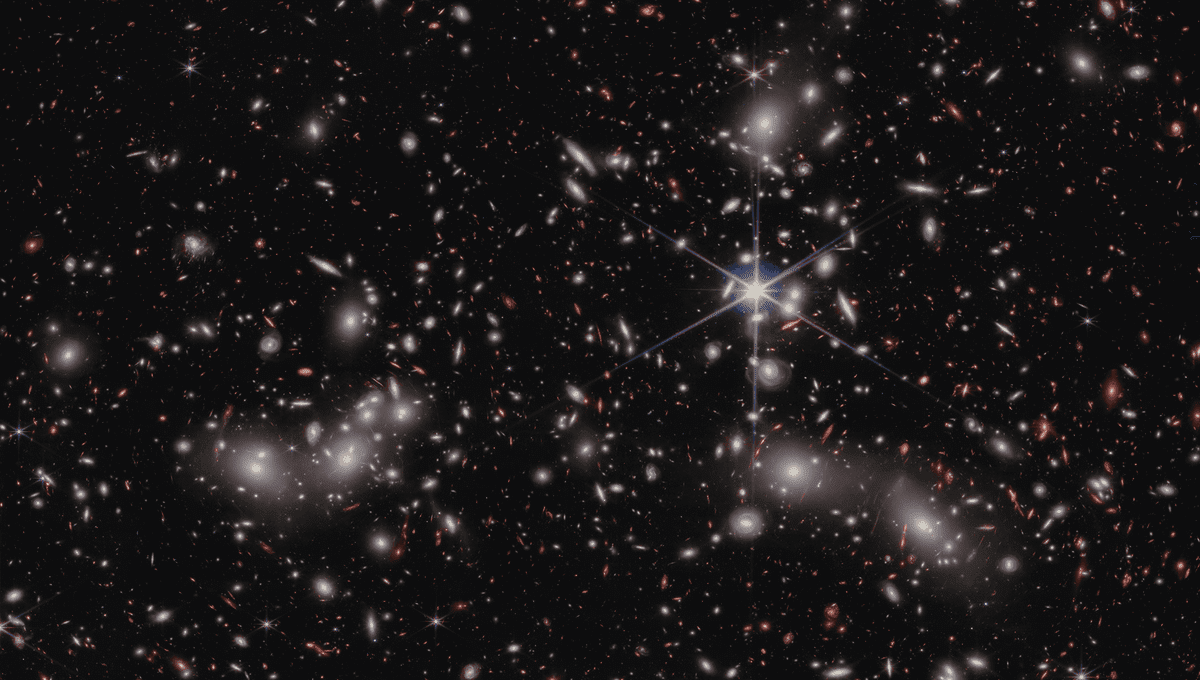
When a new telescope – especially one like JWST – comes online, there are a lot of expectations of discovering unknowns and challenging our current understanding. The expectations are bearing some tentative fruits in the many areas of focus of the telescope, but lately, the attention has been on cosmology and how observations might be finding cracks in the Standard Model of cosmology.
This is our current best understanding of the Universe. It has been developed and formulated over decades, and it has fantastic predictive power about the distribution of matter in the cosmos. It is very difficult to bring a proper challenge to it – but do not let this success fool you, the model is not perfect. Crucial components to it are dark energy and dark matter, currently completely hypothetical features. Together, they make 95 percent of the energy-matter content of the Universe, but we don’t even know if they are real.
JWST itself is not exactly hunting for dark matter and dark energy, but its work studying galaxies near and far helps refine the model. The expansion rate of the universe, which is influenced by these “dark” components, can be estimated with galaxies. Understanding how galaxies have changed and evolved provides crucial insight into the cosmological models available.
Dr Aaron Yung, a postdoctoral fellow at NASA’s Goddard Space Flight Center, is a theoretician who has been working on models long before JWST got to space. Those models influenced observation programs and now the first observations, such as from the NGDEEP survey, are taking place.
“It is really fun connecting theory to actual observations and now we’re looking forward to having the real observations come back and confront these predictions. Ultimately, we want to ask the question: what have we learned from these observations?” Dr Yung told IFLScience. “Seeing these galaxies tells us a lot about the individual sources but not so much about the evolution across cosmic time. Simulations can help us connect these snapshots and understand the underlying physics that drives their evolution.”
Those observations are where Yung’s models come in, helping to create a timeline of the evolution of these sources. The models initially assumed the standard model as a given, and predicts the evolution for large populations of galaxies based on the physics that are relatively well understood, including objects that have not yet been observed.
So the quest to challenge or confirm the cosmological model is not a flash in the dark. It will be a slow burner. Many observations will be required, although a few weird examples have been reported recently that are definitely raising eyebrows.
Just last week, we covered the existence of candidate galaxies from the early universe that are too big to have existed according to current models. Given that they are all in the same spot in the sky, if the area is representative, it implies the existence of a huge population of truly behemoth galaxies very early in the history of the cosmos – and that doesn’t fly with the Standard Model.
“Turns out that all of the galaxies that we find are so massive that there isn’t even enough gas in the universe to form these galaxies. That’s a pretty hard limit,” the lead author of that study, Professor Ivo Labbé, from the Swinburne University of Technology, told IFLScience.
For these galaxies, a possible explanation is that the models of galaxy formation are not exactly correct. They are tested on galaxies much closer to home, so these distant objects that JWST can spot are different. The light we measure, from which the mass is estimated, might have other sources other than the stars – for example, an active supermassive black hole.
Another possibility is that they are an optical illusion due to their color. Redder galaxies are usually further away, but it is possible that a very dusty nearby galaxy can appear as equally red, confusing the measurement. Further observations will confirm if they are really that distant.
“We’re not at the point that things are too hard to explain yet, but it’s causing tension,” Dr Yung explained to IFLScience. “We should wait and look forward to future programs. Some of them may be bigger or help us go deeper.”
Labbé and his team are just as eager to get more data on the handful of galaxies they have. They are not convinced that they have found the flaw in the model.
“Basically, our model for the Big Bang and the expansion of the universe is a really serious model that is really well tested. That’s not going to break anytime soon,” Labbé told IFLScience.
Another challenge to cosmology by JWST might be more subtle than that. There is tension in the Standard Model: The expansion rate of the universe has two different values depending on how it is measured, with galaxies or with the Cosmic Microwave Background (CMB). This tells us that either the model is wrong or the ways we measure this number are wrong.
This is where JWST comes in. The galaxy method needs precise distances of galaxies and this can be obtained by studying special stars called Cepheid variables. There was a hope to reconcile the two numbers if current methods are getting something wrong about these stars, but early results support how we are been calculating things. So maybe the models are wrong.
JWST will certainly change things, and might even end up upending cosmology as we currently know it – but for now, the Standard Model lives to fight another day, probably long enough that other observatories will come online to find the flaws. NASA’s Nancy Roman Telescope might be the one, but don’t worry. Dr Yung is already producing models for it ahead of its launch in May 2027.
Source Link: JWST Is Changing Our Understanding Of The Universe, But Not Destroying Cosmology Just Yet